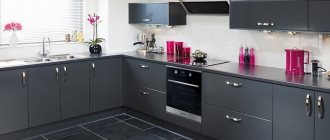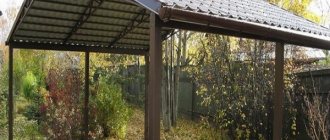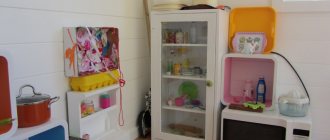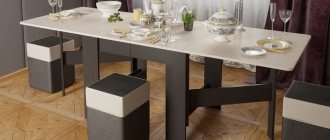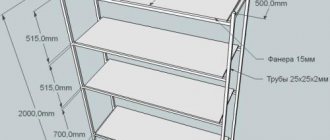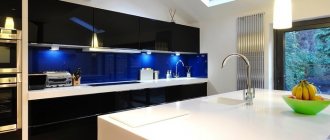Built-in hood - an excellent option for kitchens with limited space
The smell of cooking food is one of the symbols of comfort in the house. But the “omen of a delicious dinner” can permeate the entire apartment, right down to personal belongings. In addition, all housewives know how difficult it is to carry out general cleaning of the kitchen, which includes cleaning ceilings, furniture and electrical appliances from accumulated soot and greasy deposits mixed with dust. And the recent renovations may soon need to be redone. To avoid such problems, you can select and install a hood. Today, the demand for kitchen hoods is quite high, as is the number of offers on the household appliances market. And in order to choose the right device, you need to know its criteria.
Main advantages of the design
Apartment kitchens are small in size and there is not enough space for free movement. The problem is solved by installing the system inside one of the kitchen wall cabinets. An air duct passes through it, flowing smoothly into the ventilation hole on the wall, and it is possible to store things inside the cabinet with the pipe.
Scheme of work
Cabinet hoods for home use have these advantages:
- aesthetic appeal, complementing the design of the kitchen space;
- saving the spatial resource of the kitchen room;
- all pipes of the structure are completely hidden;
- fastening is reliable, practical, convenient;
- the filters are located outside, behind the grease mesh, which makes them easy to change;
- guarantee of system performance quality;
- ease of maintenance of the mechanism;
- complete safety of the presented type of mechanism;
- Possibility of installation above gas stoves and hobs.
When installing, the type of stove is taken into account, because the device should be placed higher above the gas one, and lower above the electric one. The distance from the hob is 60-80 centimeters.
Performance
Finally, let’s talk about the most important selection criterion – the performance of a built-in hood. This parameter determines how much air the device will process within an hour. Therefore, it is natural that the larger the kitchen, the higher the productivity should be.
To determine the optimal indicator for your apartment, you will need a simple mathematical calculation. Measure the kitchen area and multiply that number by the ceiling height to calculate the air volume in the room. According to the requirements of sanitary services, the air in the kitchen must be completely renewed 12 times within an hour. Accordingly, the calculated volume must be multiplied by 12, and if a gas stove is installed in the room, then by 20 (a large amount of combustion products is formed). Then, in order to take into account all extraneous factors that could affect the quality of operation of the exhaust device (carbon filter, air duct with a large number of bends, condition of ventilation ducts, etc.), the obtained result must be increased by 30%. The resulting figure is the required performance of the kitchen hood.
Basic selection tips
A hood built into a cabinet costs twice as much as a conventional kitchen design. This is determined by its structure, quality, and suitability for installation.
Opened
In order for the system to become useful in the kitchen, its selection is carried out according to this principle:
- take accurate measurements of the upper cabinet and hob;
- find a system that matches the parameters in the store and purchase it;
- if it is impossible to select the size, you should order a cabinet for the exhaust system, mount it, install the structure;
- elements of the system must be made into one unit before installation inside the cabinet;
- there are sizes of exhaust structures 45-90 centimeters;
- if the consumer needs silent operation, a corrugated pipe will not suit him.
When a corrugated pipe is purchased to reduce the noise of the system, this structural element is completely leveled. This is done by stretching. The convenience of such a device lies precisely in its flexibility and stability. At the same time, there are additional savings for installation, because No additional kneeling devices are purchased.
The cabinet under the hood is always secured with strong screws. Additionally, the structure is bolted to the adjacent wall. This prevents the kitchen cabinet from falling. It is practical to select rectangular air ducts, connecting the pipes with elbows. These additions are durable and standard on 80% of exhaust systems. The hob should be located under the exhaust structure - the latter is slightly wider than the stove.
Photos of kitchen units with built-in hood
A cabinet for a kitchen hood will allow the housewife to cook with maximum comfort, and a large selection of model designs will not only hide the device, but also introduce new elements into the kitchen interior and bring to life the most daring design solutions.
Hello dear friends!
Today we will look at how to design a similar element that is part of a kitchen set.
First you need to understand that hoods come in a wide variety of designs:
Island, built-in, wall.
All of them are structurally different from each other. Also, they are installed differently and have different effectiveness.
But in this case, we are interested in two of their types: the ordinary built-in one (the one that is attached to the bottom of the box), and the telescopic one (which is mounted in a special way).
We will look at the design of modules for this technique.
All the equipment we review is manufactured according to certain standards. (for installation in modules whose width is, for example, 500 or 600 millimeters).
The minimum depth of the module for the hood should be 280mm.
How to install a hood inside a cabinet yourself
To install a cabinet above the hood, consumers call craftsmen. Brave users undertake to do the installation themselves. The instructions for performing the process in the form give an idea of how to carry out the process step by step.
This establishing moment should be described as follows:
- install a kitchen cabinet according to size - if there is none at all;
- make a hole in the bottom, middle, top shelf that is suitable in size to the parameters of the air duct pipe;
- insert the corrugated pipe inside, making the necessary bends, a regular rectangular one, connecting at the bends with special bends;
- attach a pipe element to the back wall of the cabinet - there are holes intended for this;
- connect the air duct element to the outer head of the structure, bolt it to the bottom of the cabinet;
- install a charcoal and grease filter, install a grill;
- Additionally, use a drill to make a hole inside the back wall of the cabinet so that there is somewhere to thread the cord for the outlet.
- Connect the end of the air duct pipe (cut if necessary) to the ventilation hole in the wall.
After installation, the condition of the moving part is monitored - it should slide freely. Installation of a built-in hood in a cabinet is carried out according to the instructions. Designed for a specific model, taking into account the type of ventilation of the room, the structural features of the cabinet, its size, location.
A non-return valve is installed inside the kitchen hood. Additionally, a clamp purchased at a hardware store is installed, which helps to disassemble the structure at the time of its complete cleaning. High-quality cleaning of the hood with your own hands is carried out using special detergents. Filters are changed every 4-12 months - the period depends on the type, quality, and manufacturer of the kitchen exhaust system.
We recommend watching 2 detailed videos on how to make a cabinet above the hood
Features of operation
The operating rules for both fully built-in and canopy, retractable hoods are not much different from the use of any other household appliances. It is important to avoid overheating of the equipment (to do this, install it correctly), ingress of water, promptly wipe off dust and other contaminants, do not drop or hit, avoid twisting the wire or its contact with hot surfaces.
Regarding the hood, which is built into the cabinet, the following rules should also be observed:
- The grease filter protects the internal system of the structure, trapping droplets of fat and splashes of cooking food. The performance of the hood depends on its cleanliness. Therefore, it is necessary to regularly remove it when it becomes dirty and wash it with detergent. It can be easily removed and put back;
- The carbon filter of a recirculation hood is one of its most important elements. Over time, it loses its cleansing abilities. Therefore, it is necessary to replace it with a new one at least once every six months. There are different brands of carbon filters;
- It is necessary to ensure that the sliding panel slides out and slides back easily. To do this, it also needs to be regularly cleaned of dust, dirt and grease particles;
- If the hood has touch control, then in the kitchen it is especially susceptible to contamination. There are fingerprints on it, food splashes, and dust sticks to it all. The ease of operation of the device depends on its cleanliness, and a strong degree of contamination can lead to breakdown. Therefore, it is necessary to especially carefully monitor the cleanliness of the touch panel, wiping it with special wet wipes;
- The push-button control system can also be damaged by grease particles and kitchen fumes. When dirt gets stuck between the buttons, it can impair their performance. Therefore, the cleanliness of the control panel must be as carefully monitored as a grease filter.
If the equipment breaks down or its performance deteriorates, you must contact the service center. Timely handling can save equipment and extend its service life.
Is the exhaust system inside the cabinet safe?
The kitchen built-in hood meets domestic and international quality standards. The system adapts to installation inside a cabinet.
The safety parameters of the kitchen room element are proven by these points:
- fastening is carried out to the rear wall, the bottom of the cabinet;
- the bolts are selected strong and long;
- Manufacturers adapt designs for hobs, gas or electric. stove;
- The manufacturer sets the location parameters at a specific height.
Video instructions or user manuals included with the device upon purchase tell you how to install the hood inside the cabinet.
This system meets the required standards, removes food odors, removes steam from the room, operates continuously, and gives signals about the need to replace the filter component. The cost is higher than a regular hood, the quality is comparable to professional hoods.
The exhaust system head remains outside, the air duct, wires, and fastening elements remain inside the cabinet. When using corrugated pipes, the consumer needs to completely level them; this reduces the noise level. A hood smaller than the width of the slab will not perform high-quality work.
Dimensions vary...
Manufacturers of kitchen hoods are trying to keep up with the times, offering new solutions that will look harmonious not only with modern stoves, but also with the overall design of the room. Therefore, the range is striking in its variety of shapes, colors, materials and sizes.
If we consider the last parameter, the most important indicator in this indicator is the width of the device. After all, the efficiency of the hood depends on this: how well it will capture polluted air.
The range of existing device width options is very wide: from 30 to 120 cm. Of course, the smallest and largest options are in little demand. Two sizes are much more popular: 50 and 60 cm. 45, 80 and 90 cm are also often found. The size of the stoves and the dimensions of the kitchen premises determine the “weather” in the choice of this parameter. Therefore, it is impossible to say unequivocally that one size is better or worse than others. For example, for a small kitchen the small dimensions of the device will be relevant, which means this is an advantage, and vice versa.
Additional features of embedded systems
The fume hood functions as a grease trap, steam and odor eliminator. It is a beautiful piece of furniture.
Additional control parameters for expensive models:
- regulation of the brightness level of the built-in backlight;
- assigning voice commands to the system;
- automatic change of operating modes - depends on the intensity of use of the hob;
- setting the time to turn on and off the ventilation system using the timer mode;
- the presence of sensors that respond to the level of contamination of filtration components;
- installation of two filtration elements - performing coarse and fine cleaning at the same time.
The warranty period for high-quality, branded models is 2-3 years - this is a standard parameter. When installing an exhaust system that is installed in a closet, it is better to remove the bottom of the furniture element completely; without this option, you will have to drill a hole of the required size.
Is this type of hood good? The answer is yes, subject to proper selection and installation.
